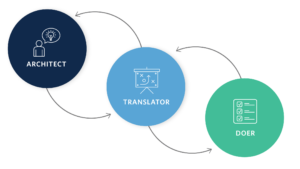Thought Leadership
Executing Organizational Strategy in Times of Crisis

“If you can keep your head when all about you are losing theirs…” Rudyard Kipling, “If”
Over the last two decades, fewer than 10% of companies have consistently achieved comprehensive and consistent execution of their chosen strategy, according to findings by UNC Kenan-Flagler Business School. The needle has barely moved since an original study conducted in the mid-1990s. If putting strategy into action is difficult under “normal” circumstances, what happens when the world is turned upside down by a global crisis?
Different hats, different times
In a recent discussion with corporate learning and development (L&D leaders), UNC Executive Development President Dave Roberts suggested a framework to guide us through the chaos caused by COVID-19. Roberts posited that the most effective leaders, including those within L&D functions, wear three hats in supporting the execution of strategy – those of architect, translator and doer.

A graphic showing the word “architect” inside a dark blue circle, the word “translation” inside a light blue circle, and the word “doer” inside a green circle.”
As architect, leaders create/author the strategy. Effective translating is communicating a tailored “why” of the strategy to different audiences, leadership and employees. The lack of targeted and compelling messaging has been clearly identified as the biggest barrier to effective strategy execution. The doer role covers everything else, potentially including measuring and communicating the ROI from L&D investments, requesting necessary resources and coaching team members – activities that generate actual value for the organization.
Many of us know that we get the time allocation mix wrong. We probably spend too much time doing and not enough architecting and translating. This is exacerbated in a crisis. In the midst of chaos, to be most effective, leaders must adapt and spend the right amount of time in each role.
Keeping your hat on in a storm
“I’m trying to build a ship with a storm going on.” – Recent comment from an L&D leader during the COVID-19 pandemic
Uncertainty generated by the current crisis impacts all of the roles we play.
- The crisis has scrambled much of our previous Architecting work – our earlier planning and prioritization might be moot, and the resources we expected to execute that design might have been reduced or allocated elsewhere.
- The crisis has produced a flood of communications, generated both internally and externally, frequently demonstrating a lack of empathy with the audience. As one global L&D director recently said, “We have to transition our leaders from telling to listening.” This complicates our translating intent to convey a consistent, coherent message that resonates and motivates.
- The crisis has radically re-ordered our daily doing: checking on our team, managing projects, and, of course, saving time for self-care. A day can feel like a week.
Roberts suggested that to be effective, we have to think differently about how we allocate both the time spent on each role and how that role changes in a crisis.
- When an L&D leader is architecting while dealing with unexpected issues raised by a crisis, they still must maintain focus on how their L&D efforts will align to the overall corporate strategy. This is especially true when that strategy changes in response to the crisis. L&D strategy components should focus on managing uncertainty, developing resilience, planning for re-entry and communication effectiveness.
- In a crisis, staff are scared and frequently look to their L&D translator to provide tailored messages that demonstrate a commitment of balance between “survive” and “thrive,” i.e. the present and the future. In the absence of clarity from the C-Suite, L&D leaders might have to craft these messages. An effective L&D leader will most likely need to spend more time on their Translator.
- When doing in a crisis, L&D leaders will find themselves taking on a myriad of new daily challenges. An example we are hearing from L&D leaders is the need to support staff who are being asked to take on roles unrelated to their “official” job – as one put it, people are being “launched, unprepared, into new roles, in new ways.”
The key to success has always been allocating the right time to each of these three roles. The COVID-19 crisis demands us to repeatedly and rapidly adapt the time allocation and role content. Learn more about how to effectively balance your time as an architect, translator, and doer.